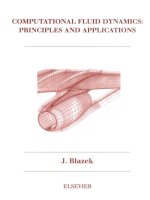vehicle dynamics theory and applications
Bạn đang xem bản rút gọn của tài liệu. Xem và tải ngay bản đầy đủ của tài liệu tại đây (13.51 MB, 1,022 trang )
Vehicle Dynamics:
Theory and Application
Reza N. Jazar
Vehicle Dynamics:
Theory and Applications
Reza N. Jazar
Dept. of Mechanical Engineering
Manhattan College
Riverdale, NY 10471
Library of Congress Control Number: 2007942198
ISBN: 978-0-387-74243-4 e-ISBN: 978-0-387-74244-1
2008 Springer Science+Business Media, LLC
All rights reserved. This work may not be translated or copied in whole or in part without the
written permission of the publisher (Springer Science+Business Media, LLC, 233 Spring
Street, New York, NY 10013, USA), except for brief excerpts in connection with reviews or
scholarly analysis. Use in connection with any form of information storage and retrieval,
electronic adaptation, computer software, or by similar or dissimilar methodology now known
or hereafter developed is forbidden. The use in this publication of trade names, trademarks,
service marks and similar terms, even if they are not identified as such, is not to be taken as an
expression of opinion as to whether or not they are subject to proprietary rights.
Printed on acid-free paper.
9 8 7 6 5 4 3 2 1
springer.com
Dedicated to
my son, Kavosh,
m y daughter, Vazan,
and my wife, Mojgan.
Happiness is when you win a race against yourself.
Preface
This text is for engineering students. It introduces the fundamental knowl-
edge used in vehicle dynamics. This knowledge can be utilized to develop
computer programs for analyzing the ride, handling, and optimization of
road vehicles.
Vehicle dynamics has been in the engineering curriculum for more than
a h undred years. Books on the subject are available, but most of them
are written for specialists and are not suitable for a classroom application.
A new student, engineer, or researcher would not know where and how
to start learning vehicle dynamics. So, there is a need for a textbook for
beginners. This textbook presents the fundamentals with a perspective on
future trends.
The study of classical vehicle dynamics has its roots in the w ork of
great scientists of the past four centuries and creative engineers in the
past century who established the methodology of dy namic systems. The
developmen t of vehicle dynamics has moved toward modeling, analysis,
and optimization of multi-body dynamics supported by some compliant
members. Therefore, merging dynamics with optimization theory was an
expected development. The fast-growing capability of accurate positioning,
sensing, and calculations, along with intelligent computer programming are
the other important developments in vehicle dynamics. So, a textbook help
the reader to make a computer model of vehicles, which this book does.
Lev el of the Book
This book has evolved from nearly a decade of research in nonlinear
dynamic systems and teaching courses in vehicle dynamics. It is addressed
primarily to the last year of undergraduate study and the first year graduate
student in engineering. Hence, it is an intermediate textbook. It provides
both fundamental and advanced topics. The whole book can be covered
in two successive courses, however, it is possible to jump over some sec-
tions and cover the book in one course. Students are required to kno w the
fundamen tals of kinematics and dynamics, as well as a basic knowledge of
numerical methods.
The contents of the book have been kept at a fairly theoretical-practical
level. Many concepts are deeply explained and their application empha-
sized, and most of the related theories and formal proofs have been ex-
plained. The book places a strong emphasis on the physical meaning and
applications of the concepts. Topics that have been selected are of h igh
interest in the field. An attempt has been made to expose students to a
x Preface
broad range of topics and approaches.
There are four special chapters that are indirectly related to vehicle dy-
namics: Applied Kinematics, Applied Mec hanisms, Applied Dynamics,and
Applied Vibrations. These chapters provide the related background to un-
derstand vehicle dynamics and its subsystems.
Organization of the Book
The text is organized so it can be used for teaching or for self-study.
Chapter 1 “Fundamentals,” contains general preliminaries about tire and
rim with a brief review of road vehicle classifications.
Part I “One Dimensional Vehicle Dynamics,” presents forward vehicle
dynamics, tire dynamics, and driveline dynamics. Forw ard dynamics refers
to weight transfer, accelerating, braking, engine performance, and gear ratio
design.
Part II “Vehicle Kinematics,” presents a detailed discussion of vehicle
mechanical subsystems such as steering and suspensions.
Part III “Vehicle Dynamics,” employs Newton and Lagrange methods
to develop the maneuvering dynamics of vehicles.
Part IV “Vehicle Vibrations,” presents a detailed discussion of vehi-
cle vibrations. An attempt is made to review the basic approaches and
demonstrate how a vehicle can be modeled as a vibrating multiple degree-
of-freedom system. The concepts of the Newton-Euler dynamics and La-
grangian method are used equally for derivation of equations of motion.
The RMS optimization technique for suspension design of vehicles is intro-
duced and applied to vehicle suspensions. The outcome of the optimization
tec hnique is the optimal stiffness and damping for a car or suspended equip-
ment.
Method of Presentation
This book uses a "fact-reason-application" structure. The "fact" is the
main subject we introduce in each section. Then the reason is given as a
"proof." The application of the fact is examined in some "examples." The
"examples" are a very important part of the book because they show how
to implement the "facts." They also cover some other facts that are needed
to expand the subject.
Prerequisites
Since the book is written for senior undergraduate and first-year graduate-
lev el studen ts of engineering, the assumption is t hat users are familiar with
matrix algebra as well as basic dynamics. Prerequisites are the fundamen-
tals of kinematics, dynamics, vector analysis, and matrix theory. These
basics are usually taught in the first three undergraduate years.
Unit System
The system of units adopted i n this book is, unless otherwise stated, the
in ternational system of units (SI). The units of degree (deg)orradian(rad)
are utilized for variables representing angular quantities.
Symbols
• Lowercase bold letters indicate a vector. Vectors may be expressed in
an n dimensional Euclidian space. Example:
r , s , d , a , b , c
p , q , v , w , y , z
ω , α , ² , θ , δ , φ
• Uppercase bold letters indicate a dynamic vector or a dynamic ma-
trix, such as force and moment. Example:
F
,
M
• Lowercase letters with a hat indicate a unit vector. Unit vectors are
not bolded. Example:
ˆı , ˆj ,
ˆ
k , ˆe , ˆu , ˆn
ˆ
I ,
ˆ
J ,
ˆ
K , ˆe
θ
, ˆe
ϕ
, ˆe
ψ
• Lo wercase letters with a tilde indicate a 3 ×3 skew symmetric matrix
associated to a v ector. Example:
˜a =
⎡
⎣
0 −a
3
a
2
a
3
0 −a
1
−a
2
a
1
0
⎤
⎦
,
a =
⎡
⎣
a
1
a
2
a
3
⎤
⎦
• An arrow above two uppercase letters indicates the start and end
points of a position vector. Example:
−−→
ON = a position vector from point O to point N
• The length of a vector is indicated by a non-bold lowercase letter.
Example:
r = |r|
,
a = |a|
,
b = |b|
,
s = |s|
• Capital letter B is utilized to denote a body coordinate frame. Ex-
ample:
B(oxyz)
,
B(Oxyz)
,
B
1
(o
1
x
1
y
1
z
1
)
Preface xi
Preface
• Capital letter G is utilized to denote a global, inertial, or fixed coor-
dinate frame. Example:
G
,
G(XY Z)
,
G(OXY Z)
• Right subscript on a transformation matrix indicates the departur e
frames. Example:
R
B
= transformation matrix from frame B(oxyz)
• Left superscript on a transformation matrix indicates the destination
frame. Example:
G
R
B
= transformation matrix from frame B(oxyz)
to frame G(OXY Z)
• Capital letter R indicates rotation or a transformation matrix, if it
shows the beginning and destination coordinate frames. Example:
G
R
B
=
⎡
⎣
cos α −sin α 0
sin α cos α 0
001
⎤
⎦
• Whenever there is no sub or superscript, the matrices are shown in a
brac ket. Example:
[T ]=
⎡
⎣
cos α −sin α 0
sin α cos α 0
001
⎤
⎦
• Left superscript on a vector denotes the frame in which the vector
is expressed. That superscript indicates the frame that the vector
belongs to; so the vector is expressed using the unit vectors of that
frame. Example:
G
r = position ve ctor expressed in frame G(OXY Z)
• Right subscript on a vector denotes the tip point that the vector is
referred to. Example:
G
r
P
= position vector of point P
expressed in coordinate frame G(OXY Z)
• Right subscript on an angular velocity vector indicates the frame that
the angular vector is referred to. Example:
ω
B
= angular velocity of the body coordinate frame B(oxyz)
xii
Preface xii
• Left subscript on an angular velocity vector indicates the frame that
the angular vector is measured with respect to. Exa mple:
G
ω
B
= angular velocity of the body coordinate frame B(oxyz)
with respect to the global coordinate frame G(OXY Z)
• Left superscript on an angular velocity vector denotes the frame in
which the angular velocity is expressed. Example:
B
2
G
ω
B
1
= angular velocity of the body coordinate frame B
1
with respect to the global coordinate frame G,
and expressed in body coordinate frame B
2
Whenever the subscript and superscript of an angular velocity are
the same, w e usually drop the left superscript. Example:
G
ω
B
≡
G
G
ω
B
Also for position, velocity, and acceleration vectors, we drop the left
subscripts if it is the same as the left superscript. Example:
B
B
v
P
≡
B
v
P
• Left superscript on derivative operators indicates the frame in which
the derivative of a variable is taken. Example:
G
d
dt
x
,
G
d
dt
B
r
P
,
B
d
dt
G
B
r
P
If the variable is a vector function, and also the frame in which the
vector is defined is the same frame in which a time derivative is taken,
we may use the following short notation,
G
d
dt
G
r
P
=
G
˙r
P
,
B
d
dt
B
o
r
P
=
B
o
˙r
P
and write equations simpler. Example:
G
v =
G
d
dt
G
r(t)=
G
˙r
• If followed by angles, lowercase c and s denote cos and sin functions
in mathematical equations. Example:
cα =cosα
,
sϕ =sinϕ
i
x vi Preface
• Capital bold letter I indicates a unit matrix, which, depending on
the dimension of the matrix equation, could be a 3 × 3 or a 4 × 4
unit matrix. I
3
or I
4
are also being used to clarify the dimension of
I.Example:
I = I
3
=
⎡
⎣
100
010
001
⎤
⎦
• An asterisk F indicates a more advanced subject or example that is
not designed for undergraduate teaching and can be dropped in the
first reading.
Con ten ts
Preface x
1 Tire and Rim Fundamentals 1
1.1 TiresandSidewallInformation 1
1.2 TireComponents 11
1.3 RadialandNon-RadialTires 14
1.4 Tread 17
1.5 F Hydroplaning 18
1.6 Tireprint 20
1.7 WheelandRim 21
1.8 Vehicle Classifications 25
1.8.1 ISO and FHWA Classification 25
1.8.2 Passenger Car Classifications 28
1.8.3 PassengerCarBodyStyles 30
1.9 Summary 31
1.10KeySymbols 33
Exercises 34
I One-Dimensional Vehicle Dynam ics 37
2ForwardVehicleDynamics 39
2.1 ParkedCaronaLevelRoad 39
2.2 ParkedCaronanInclinedRoad 44
2.3 AcceleratingCaronaLevelRoad 50
2.4 AcceleratingCaronanInclinedRoad 55
2.5 ParkedCaronaBankedRoad 65
2.6 F OptimalDriveandBrakeForceDistribution 68
2.7 F VehiclesWithMoreThanTwoAxles 74
2.8 F VehiclesonaCrestandDip 78
2.8.1 F VehiclesonaCrest 78
2.8.2 F VehiclesonaDip 82
2.9 Summary 87
2.10KeySymbols 88
Exercises 90
3 Tire Dynamics 95
3.1 TireCoordinateFrameandTireForceSystem 95
i
3.2 Tire Stiffness 98
3.3 TireprintForces 104
3.3.1 StaticTire,NormalStress 104
3.3.2 StaticTire,TangentialStresses 108
3.4 EffectiveRadius 109
3.5 RollingResistance 114
3.5.1 F Effect of Speed on the Rolling Friction Coefficient 119
3.5.2 F Effect of Inflation Pressure and Load on the Rolling
Friction Coefficient 122
3.5.3 F Effect of Sideslip Angle on Rolling Resistance . . 125
3.5.4 F Effect of Camber Angle on Rolling Resistance . . 127
3.6 LongitudinalForce 127
3.7 LateralForce 135
3.8 CamberForce 145
3.9 TireForce 151
3.10Summary 157
3.11KeySymbols 159
Exercises 161
4 Driveline Dynamics 165
4.1 EngineDynamics 165
4.2 Driveline and Efficiency 173
4.3 GearboxandClutchDynamics 178
4.4 GearboxDesign 187
4.4.1 GeometricRatioGearboxDesign 188
4.4.2 F ProgressiveRatioGearboxDesign 190
4.5 Summary 205
4.6 KeySymbols 207
Exercises 209
II Ve hicle K inematics 217
5 Applied Kinematics 219
5.1 RotationAboutGlobalCartesianAxes 219
5.2 SuccessiveRotationAboutGlobalCartesianAxes 223
5.3 RotationAboutLocalCartesianAxes 225
5.4 SuccessiveRotationAboutLocalCartesianAxes 229
5.5 F EulerAngles 231
5.6 GeneralTransformation 241
5.7 AngularVelocity 248
5.8 F TimeDerivativeandCoordinateFrames 257
5.9 RigidBodyVelocity 267
5.10 Angular Acceleration . . . 272
5.11RigidBodyAcceleration 279
Conten ts
xvi
5.12 F Axis-angleRotation 282
5.13 F ScrewMotion 288
5.14Summary 301
5.15KeySymbols 304
Exercises 305
6 Applied Mechanisms 309
6.1 Four-BarLinkage 309
6.2 Slider-CrankMechanism 332
6.3 InvertedSlider-CrankMechanism 339
6.4 InstantCenterofRotation 346
6.5 CouplerPointCurve 356
6.5.1 CouplerPointCurveforFour-BarLinkages 356
6.5.2 Coupler Point Curve for a Slider-Crank Mech anism . 360
6.5.3 Coupler Poin t Curve for Inverted Slider-Crank Mech-
anism 362
6.6 F UniversalJointDynamics 363
6.7 Summary 372
6.8 KeySymbols 373
Exercises 374
7 Steering Dynamics 379
7.1 KinematicSteering 379
7.2 VehicleswithMoreThanTwoAxles 395
7.3 F VehiclewithTrailer 398
7.4 SteeringMechanisms 403
7.5 F Fourwheelsteering 409
7.6 F SteeringMechanismOptimization 424
7.7 F Trailer-TruckKinematics 434
7.8 Summary 447
7.9 KeySymbols 449
Exercises 451
8 Suspension Mechanisms 455
8.1 SolidAxleSuspension 455
8.2 IndependentSuspension 465
8.3 RollCenterandRollAxis 470
8.4 F CarTireRelativeAngles 478
8.4.1 F Toe 479
8.4.2 F CasterAngle 482
8.4.3 F Camber 483
8.4.4 F TrustAngle 483
8.5 SuspensionRequirementsandCoordinateFrames 485
8.5.1 KinematicRequirements 485
8.5.2 DynamicRequirements 486
Conten ts
xvi i
8.5.3 Wheel, wheel-body, and tire Coordinate Frames . . . 487
8.6 F CasterTheory 497
8.7 Summary 508
8.8 KeySymbols 510
Exercises 512
III Vehicle Dynamics 519
9 Applied Dynamics 521
9.1 ForceandMoment 521
9.2 RigidBodyTranslationalDynamics 528
9.3 RigidBodyRotationalDynamics 530
9.4 MassMomentofInertiaMatrix 542
9.5 Lagrange’sFormofNewton’sEquationsofMotion 554
9.6 LagrangianMechanics 561
9.7 Summary 571
9.8 KeySymbols 574
Exercises 575
10 Vehicle Planar Dynamics 583
10.1VehicleCoordinateFrame 583
10.2RigidVehicleNewton-EulerDynamics 589
10.3ForceSystemActingonaRigidVehicle 597
10.3.1 TireForceandBodyForceSystems 597
10.3.2 TireLateralForce 600
10.3.3 Two-wheel Model and Body Force Components . . . 601
10.4Two-wheelRigidVehicleDynamics 609
10.5Steady-StateTurning 620
10.6 F LinearizedModelforaTwo-WheelVehicle 631
10.7 F TimeResponse 635
10.8Summary 655
10.9KeySymbols 657
Exercises 659
11 F Vehicle Roll Dynamics 665
11.1 F VehicleCoordinateandDOF 665
11.2 F EquationsofMotion 666
11.3 F VehicleForceSystem 671
11.3.1 F TireandBodyForceSystems 671
11.3.2 F TireLateralForce 674
11.3.3 F Body Force Components on a Two-wheel Model . 677
11.4 F Two-wheelRigidVehicleDynamics 684
11.5 F Steady-StateMotion 688
11.6 F TimeResponse 693
Conten ts
xviii
11.7Summary 710
11.8KeySymbols 712
Exercises 715
IV Ve hicle V ibration 727
12 Applied Vibrations 729
12.1MechanicalVibrationElements 729
12.2Newton’sMethodandVibrations 738
12.3FrequencyResponseofVibratingSystems 744
12.3.1 ForcedExcitation 745
12.3.2 BaseExcitation 756
12.3.3 Eccentric Excitation 768
12.3.4 F EccentricBaseExcitation 775
12.3.5 F Classification for the Frequency Responses of One-
DOFForcedVibrationSystems 781
12.4TimeResponseofVibratingSystems 786
12.5VibrationApplicationandMeasurement 799
12.6 F VibrationOptimizationTheory 804
12.7Summary 816
12.8KeySymbols 818
Exercises 821
13 Vehicle Vibrations 827
13.1LagrangeMethodandDissipationFunction 827
13.2 F Quadratures 838
13.3NaturalFrequenciesandModeShapes 845
13.4BicycleCarandBodyPitchMode 853
13.5HalfCarandBodyRollMode 858
13.6FullCarVibratingModel 864
13.7Summary 875
13.8KeySymbols 876
Exercises 878
14 Suspension Optimization 883
14.1MathematicalModel 883
14.2FrequencyResponse 890
14.3RMSOptimization 894
14.4 F TimeResponseOptimization 918
14.5Summary 924
14.6KeySymbols 925
Exercises 927
15 F Quarter Car 931
Conten ts
x ix
15.1MathematicalModel 931
15.2FrequencyResponse 933
15.3 F NaturalandInvariantFrequencies 938
15.4 F RMSOptimization 953
15.5 F Optimization Based on Natural Frequency and Wheel
Travel 964
15.6Summary 970
15.7KeySymbols 971
Exercises 973
References 977
A Frequency Response Curves 983
B Trigonometric Formulas 989
C Unit Conversions 993
Index 997
Conten ts
xx
1
Tire and Rim Fundam en tals
We introduce and review some topics about tires, wheels, roads, vehicles,
and their interactions. These subjects are needed to understand vehicle
dynamics better.
1.1 Tires and Sidewall Information
Pneumatic tires are the only means to transfer forces between the road and
the vehicle. Tires are required to produce the forces necessary to control
the vehicle, and hence, th ey are an important component of a vehicle.
Figure 1.1 illustrates a cross section view of a tire on a rim to show the
dimension parameters that are used to standard tires.
P
a
n
w
i
d
t
h
w
T
, Section width
h
T
, Section height
Tireprint width
Sidewall
FIGURE 1.1. Cross section of a tire on a rim to show tire height and width.
The section height, tire height,orsimplyheight, h
T
,isanumberthat
must be added to the rim radius to make the wheel radius. The section
width,ortire width, w
T
, is the widest dimension of a tire when the tire is
not loaded.
Tires are required to have certain information printed on the tire sid ewall.
Figure 1.2 illustrates a side view of a sample tire to show the important
information printed on a tire sidewall.
1
Tire and Rim Fundam en tals
We introduce and review some topics about tires, wheels, roads, vehicles,
and their interactions. These subjects are needed to understand vehicle
dynamics better.
1.1 Tires and Sidewall Information
Pneumatic tires are the only means to transfer forces between the road and
the vehicle. Tires are required to produce the forces necessary to control
the vehicle, and hence, th ey are an important component of a vehicle.
Figure 1.1 illustrates a cross section view of a tire on a rim to show the
dimension parameters that are used to standard tires.
P
a
n
w
i
d
t
h
w
T
, Section width
h
T
, Section height
Tireprint width
Sidewall
FIGURE 1.1. Cross section of a tire on a rim to show tire height and width.
The section height, tire height,orsimplyheight, h
T
,isanumberthat
must be added to the rim radius to make the wheel radius. The section
width,ortire width, w
T
, is the widest dimension of a tire when the tire is
not loaded.
Tires are required to have certain information printed on the tire sid ewall.
Figure 1.2 illustrates a side view of a sample tire to show the important
information printed on a tire sidewall.
2 1. Tire and Rim Fundamentals
R
A
D
I
A
L
P
2
1
R
1
5
5
/
6
0
M
&
S
F
O
R
R
E
I
N
C
E
D
i
M
A
D
N
C
A
N
A
E
I
D
A
9
6
H
P
2
1
R
1
5
5
/
6
0
9
6
H
T
U
B
L
E
S
S
E
D
O
T
7
C
D
E
F
F
A
3
0
9
E
1
1
2
5
4
0
1
M
A
X
S
U
R
4
0
P
R
E
S
P
s
1
2
3
4
5
1
6
7
8
P
0
A
R
E
A
+
2
S
T
I
R
FIGURE 1.2. Side view of a tire and the most important information printed on
a tire sidewall.
The codes in Figure 1.2 are:
1 Size number.
2 Maximum allowed inflation pressure.
3 Type of tire construction.
4 M&S denotes a tire for mud and snow.
5 E-MarkistheEuropetypeapprovalmarkandnumber.
6 US Department of Transport (DOT) identification numbers.
7 Country of manufacture.
8 Manu facturers, brand name, or commercial name.
The most important information on the sidewall of a tire is the size
number, indicated by
1 . To see the format of the size number, an example
isshowninFigure1.3andtheirdefinitions are explained as follows.
P Tire type.Thefirst letter indicates the proper type of car that the
tire is made for.
P stands for passenger car. The first letter can also be
ST for special trailer, T for temporary, and LT for light truck.
215 Tire width. This three-number code is the width of the unloaded
tire from sidewall to sidewall measured in [mm].
1. Tire and Rim Fundamentals 3
Passenger car
Tire width [mm]
Aspect ratio [%]
Radial
Rim diameter [in]
Load rating
Speed rating
P
215
60
R
15
96
H
P 215 / 60 R 15 96 H
FIGURE 1.3. A sample of a tire size numb er and its meaning.
60 Aspect ratio. This two-num ber code is the ratio of the tire section
height to tire width, expressed as a percentage. Aspect ratio is shown by
s
T
.
s
T
=
h
T
w
T
× 100 (1.1)
Generally speaking, tire aspect ratios range from 35, for race car tires, to
75 for tires used on utility vehicles.
R Tire construction type. The letter R indicates that the tire has
a radial construction. It may also be
B forbiasbeltorbiasply,and
D for diagonal.
15 Rim diameter.Thisisanumberin[in] to indicate diameter of the
rim that the tire is designed to fiton.
96 Load rate or load index. Many tires come with a service description
at the end of the tire size. The service description is made of a two-digit
n umber (load index) and a letter (speed rating). The load index is a rep-
resentation of the maxim um load each tire is designed to support.
Table 1.1 shows some of the most common load indices and their load-
carrying capacities. The load index is generally valid for speeds under
210 km/ h (≈ 130 mi/ h).
H Speed rate. Speed rate indicates the maximum speed that the tire
can sustain for a ten minute endurance without breaking down.
Table 1.2 shows the most common speed rate indices and their meanings.
Example 1 Weightofacarandloadindexofitstire.
For a car that weighs 2 tons = 2000 kg, we need a tire with a lo ad index
higher than 84. This is b ecause we have about 500 kg per tire and it is in a
load index of 84.
4 1. Tire and Rim Fundamentals
Table 1.1 - Maximum load-carrying capacity tire i ndex.
Index Maximum load Index Maximum load
0 45 kg ≈ 99 lbf
··· ··· 100 800 kg ≈ 1764 lbf
71 345 kg ≈ 761 lbf 101 825 kg ≈ 1819 lbf
72 355 kg ≈ 783 lbf 102 850 kg ≈ 1874 lbf
73 365 kg ≈ 805 lbf 103 875 kg ≈ 1929 lbf
74 375 kg ≈ 827 lbf 104 900 kg ≈ 1984 lbf
75 387 kg ≈ 853 lbf 105 925 kg ≈ 2039 lbf
76 400 kg ≈ 882 lbf 106 950 kg ≈ 2094 lbf
77 412 kg ≈ 908 lbf 107 975 kg ≈ 2149 lbf
78 425 kg ≈ 937 lbf 108 1000 kg ≈ 2205 lbf
79 437 kg ≈ 963 lbf 109 1030 kg ≈ 2271 lbf
80 450 kg ≈ 992 lbf 110 1060 kg ≈ 2337 lbf
81 462 kg ≈ 1019 lbf 111 1090 kg ≈ 2403 lbf
82 475 kg ≈ 1047 lbf 113 1120 kg ≈ 2469 lbf
83 487 kg ≈ 1074 lbf 113 1150 kg ≈ 2581 lbf
84 500 kg ≈ 1102 lbf 114 1180 kg ≈ 2601 lbf
85 515 kg ≈ 1135 lbf 115 1215 kg ≈ 2679 lbf
86 530 kg ≈ 1163 lbf 116 1250 kg ≈ 2806 lbf
87 545 kg ≈ 1201 lbf 117 1285 kg ≈ 2833 lbf
88 560 kg ≈ 1235 lbf 118 1320 kg ≈ 2910 lbf
89 580 kg ≈ 1279 lbf 119 1360 kg ≈ 3074 lbf
90 600 kg ≈ 1323 lbf 120 1400 kg ≈ 3086 lbf
91 615 kg ≈ 1356 lbf 121 1450 kg ≈ 3197 lbf
92 630 kg ≈ 1389 lbf 122 1500 kg ≈ 3368 lbf
93 650 kg ≈ 1433 lbf 123 1550 kg ≈ 3417 lbf
94 670 kg ≈ 1477 lbf 124 1600 kg ≈ 3527 lbf
95 690 kg ≈ 1521 lbf 125 1650 kg ≈ 3690 lbf
96 710 kg ≈ 1565 lbf 126 1700 kg ≈ 3748 lbf
97 730 kg ≈ 1609 lbf 127 1750 kg ≈ 3858 lbf
98 750 kg ≈ 1653 lbf 128 1800 kg ≈ 3968 lbf
99 775 kg ≈ 1709 lbf ··· ···
199 13600 kg ≈ 30000 lbf
Example 2 Height of a tire based on tire numbers.
A tire has the size number P 215/60R15 96H. The aspect ratio 60 means
the height of the tire is equal to 60% of the tire width. To calculate the tire
height in [mm], we should multiply the first number (215) by the second
number (60) and divide by 100.
h
T
= 215 ×
60
100
= 129 mm (1.2)
This is the tire height from rim to tread.
1. Tire and Rim Fundamentals 5
Table 1.2 - Maximum speed tire index.
Index Maximum speed Index Maximum speed
B 50 km/ h ≈ 31 mi/ h P 150 km/ h ≈ 93 mi/ h
C 60 km/ h ≈ 37 mi/ h Q 160 km/ h ≈ 100 mi/ h
D 65 km/ h ≈ 40 mi/ h R 170 km/ h ≈ 106 mi/ h
E 70 km/ h ≈ 43 mi/ h S 180 km/ h ≈ 112 mi/ h
F 80 km/ h ≈ 50 mi/ h T 190 km/ h ≈ 118 mi/ h
G 90 km/ h ≈ 56 mi/ h U 200 km/ h ≈ 124 mi/ h
J 100 km/ h ≈ 62 mi/ h H 210 km/ h ≈ 130mi/ h
K 110 km/ h ≈ 68 mi/ h V 240 km/ h ≈ 150 mi/ h
L 120 km/ h ≈ 75 mi/ h W 270 km/ h ≈ 168 mi/ h
M 130 km/ h ≈ 81 mi/ h Y 300 km/ h ≈ 188 mi/ h
N 140 km/ h ≈ 87 mi/ h Z +240 km/ h ≈ +149 mi/ h
Example 3 Alternative tire size indication.
If the load index is not indicated on the tire, then a tire with a size number
such as 255/50R17 100V mayalsobenumberedby255/50VR17.
Example 4 Tire and rim widths.
The dimensions of a tire are dependent on the rim on which it is mounted.
For tires with an aspect ratio of 50 and above, the rim width is approxi-
mately 70% of the tire’s width, rounded to the nearest 0.5in.Asanexample,
a P 255/50R16 tire has a design width of 255 mm = 10.04 in however, 70%
of 10.04 in is 7.028 in, which rounded to the nearest 0.5in,is7in. Therefore,
a P 255/50R16 tire should be mounted on a 7 × 16 rim.
For t ires with aspect ratio 45 and below, the rim width is 85% of the tire’s
section width, rounded to the nearest 0.5in. For example, a P255/45R17
tire with a section width of 255 mm = 10.04 in, needs an 8.5in
rim because
85% of 10.04 in is 8.534 in ≈ 8.5in. Therefore, a P 255/45R17 tire should
be mounted on an 8
1
2
× 17 rim.
Example 5 Calculating tire diameter and radius.
We are able to calculate the overall diameter of a tire using the tire size
numbers. By multiplying the tire width and the aspect ratio, we get the tire
height. As an example, we use tire number P 235/75R15.
h
T
= 235 × 75%
= 176.25 mm ≈ 6.94 in (1.3)
Then, we add twice the tire height h
T
to the rim diameter to determine the
6 1. Tire and Rim Fundamentals
tire’s unloaded diameter D =2R and radius R.
D =2× 6.94 + 15
=28.88 in ≈ 733.8mm (1.4)
R = D/2 = 366.9mm (1.5)
Example 6 Speed rating code.
Two similar tires are coded as P 235/70HR15 and P235/70R15 100H.
Both tires have cod e H ≡ 210 km/ h for speed rating. However, the second
tire can sustain the coded speed only when it is loaded less than the specifi ed
load index, so it states 100H ≡ 800 kg 210 km/ h.
Speed ratings generally depend on the type of tire. Off road vehicles usu-
ally use Q-rated tires, passenger cars usually use R-rated tires for typical
street c ars or T -rated for performance cars.
Example 7 Tire weight.
The average weight of a tire for passenger cars is 10 −12 kg. The weight
of a tire for light truck s is 14−16 kg, and the average weight of commercial
truck tires is 135 − 180 kg.
Example 8 Effects of aspect ratio.
A higher aspect ratio provides a softer ride and an increase in deflection
under the load of the vehicle. However, lower aspect ratio tires are normally
used for higher performance vehicles. They have a wider road contact area
and a faster respo nse. This results in less deflection under load, causing a
rougher ride to the vehicle.
Changing to a tire with a different aspect ratio will result in a different
contact area, therefore changing the load capacity of the tire.
Example 9 F BMW tire size c ode.
BMW, a European car, uses the metric system for sizing its tires. As
an example, TD230/55ZR390 isametrictiresizecode.TD indicates the
BMW TD model, 230 is the section width in [mm], 55 is the aspect ratio in
percent, Z is the speed rating, R means radial, and 390 is the rim diameter
in [mm].
Example 10 F "MS," "M + S," "M/S," and "M&S"signs.
The sign "MS,"and "M + S," and "M/S," and "M&S"indicatethat
the tir e has some mud and snow capability. Most r adial tires have one of
these signs.
Example 11 F U.S. DOT tire identification number.
The US t ire identification number is in the format "DOT DNZE ABCD
1309." It begins with the letters D OT to indicate that the tire me e ts US fed-
eral standards. DOT stands for Department of Transportation. The next
two characters, DN, after DOT is the plant code, which refers to the man-
ufacturer and the factory location at which the tire was made.









